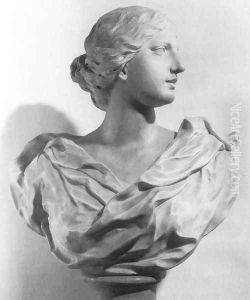Giuseppe Piamontini Paintings
Giuseppe Piamontini was an influential Italian sculptor of the Baroque period, born in 1664 in Florence, Italy. His work is characterized by its dynamic forms, intricate detail, and expressive figures, typical of the Baroque movement that sought to evoke emotion and bring religious themes to life in a dramatic way. Piamontini was a significant figure in the Florentine art scene, contributing to the rich artistic legacy of the city during a period when it was a vibrant center of creativity and innovation.
Piamontini received his early training in the bustling workshops of Florence, a city that was home to a thriving community of artists, craftsmen, and patrons. He was deeply influenced by the works of Gian Lorenzo Bernini, the prominent Roman sculptor and architect whose dramatic and lifelike sculptures defined the Baroque style. Though Piamontini spent most of his career in Florence, the influence of Bernini's works, which he studied through engravings and possibly during a visit to Rome, is evident in his dynamic compositions and detailed rendering of human figures and emotions.
Throughout his career, Piamontini worked on a variety of commissions, including religious sculptures, funerary monuments, and decorative pieces for private patrons. One of his most notable works is the series of bronze statues for the Corsini Chapel in Florence, which showcase his mastery of bronze casting and his ability to imbue his figures with a sense of movement and emotional intensity. His sculptures often featured mythological or allegorical subjects, rendered with a keen attention to anatomical accuracy and a flair for dramatic expression.
Despite his talent and contributions to the Baroque movement in Florence, Piamontini has not received the same level of recognition as some of his contemporaries. However, his work remains an important part of Italy's artistic heritage, offering insight into the Baroque period's stylistic evolution and its impact on the development of European art. Piamontini's sculptures continue to be studied and admired for their technical skill, emotional depth, and aesthetic beauty.
Giuseppe Piamontini died in 1742 in Florence, leaving behind a legacy of artistic achievement that contributes to our understanding of the Baroque period's complexities. His work reflects the broader cultural and artistic trends of his time, embodying the spirit of an era that valued emotional expressiveness, dynamic forms, and the integration of the arts into public and private life.
